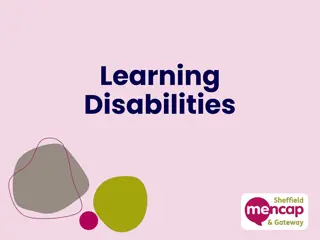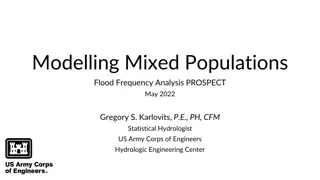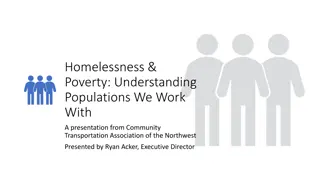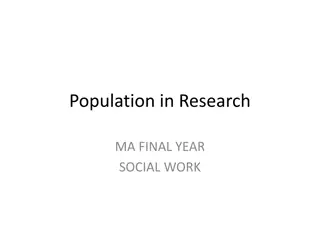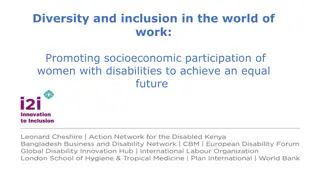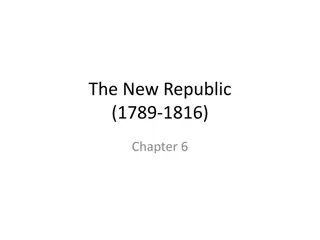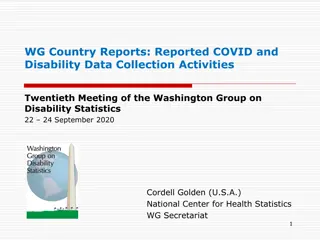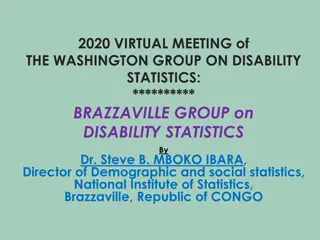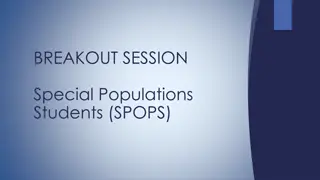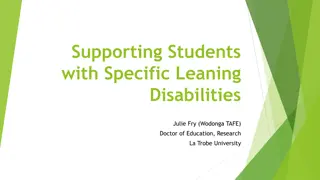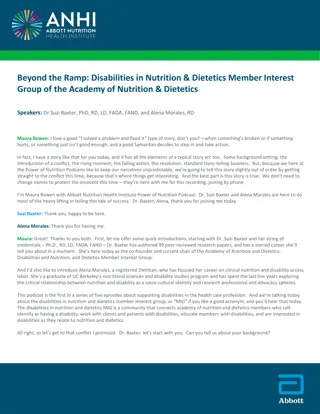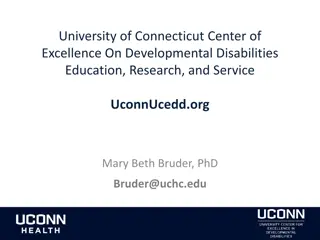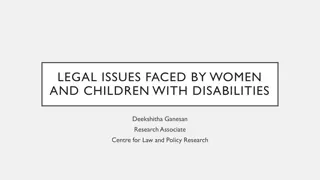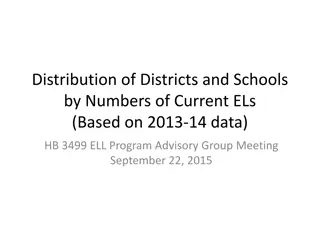Identifying Populations with Disabilities Using Washington Group Questions
Explore how the Washington Group Short Set questions can be utilized to identify different populations with disabilities, understand the impact of different disability definitions on data findings, and learn about the recommended question set for disability data disaggregation in monitoring CRPD and SDGs.
Download Presentation

Please find below an Image/Link to download the presentation.
The content on the website is provided AS IS for your information and personal use only. It may not be sold, licensed, or shared on other websites without obtaining consent from the author.If you encounter any issues during the download, it is possible that the publisher has removed the file from their server.
You are allowed to download the files provided on this website for personal or commercial use, subject to the condition that they are used lawfully. All files are the property of their respective owners.
The content on the website is provided AS IS for your information and personal use only. It may not be sold, licensed, or shared on other websites without obtaining consent from the author.
E N D
Presentation Transcript
Session 3 Identifying the population with disabilities using the Washington Group Questions Disability Data Advocacy Workshop for Organisations of Persons with Disabilities
Session overview 2 Disability Data Advocacy Workshop for Organisations of Persons with Disabilities SESSION 3
Overview of session Look through the recommended set of questions to identify the population with disabilities. Explore how the questions can be used to identify different populations with disabilities. Explore how different definitions of disability can affect data findings on: Prevalence of disability Disaggregation of indicators 3 Disability Data Advocacy Workshop for Organisations of Persons with Disabilities SESSION 3
Recommended WG question set to disaggregate data to monitor the CRPD and the SDGs 4 Disability Data Advocacy Workshop for Organisations of Persons with Disabilities SESSION 3
Washington Group Short Set (WG-SS) The WG developed a set of questions to identify those who: because of difficulties doing certain universal,basic actions, are at greater risk than the general population, for limitationsinparticipation. WG SS can be used to disaggregate data by disability status to monitor the CRPD and SDGs. 5 Disability Data Advocacy Workshop for Organisations of Persons with Disabilities SESSION 3
What questions are included in WG-SS? 1) Do you have difficulty seeing even if wearing glasses? 2) Do you have difficulty hearing even if using a hearing aid? 3) Do you have difficulty walking or climbing steps? 4) Do you have difficulty remembering or concentrating? 5) Do you have difficulty with (self-care such as) washing all over or dressing? 6) Using your usual language, do you have difficulty communicating (for example understanding or being understood by others)? Response categories: No difficulty; Some difficulty; A lot of difficulty; Cannot do at all 6 Disability Data Advocacy Workshop for Organisations of Persons with Disabilities SESSION 3
The WG-SS is the recommended question set for disability data disaggregation Used in censuses or surveys in over 80 countries. Promoted as the means to collect disability data and disaggregate by disability status by: International aid donors (e.g., FCDO/UK and DFAT/Australia) UN Statistics Division and the UN Economic Commission for Europe the Incheon Strategy on Making the Right Real in Asia UN DESA s Disability Data Experts' Group 7 Disability Data Advocacy Workshop for Organisations of Persons with Disabilities SESSION 3
How does the WG-SS measure difficulties? 8 Disability Data Advocacy Workshop for Organisations of Persons with Disabilities SESSION 3
How do the WG-SS questions ask about degree of difficulty? Each WG question has four answer options to find out the degree of difficulty the person may experience in different domains of functioning (e.g., difficulty with walking). Gathering data on the degrees of difficulty collects more information than asking a yes/no question. This is important because people s experience of disability is not as simple as 'yes or no'. Most people experience difficulties with functioning to varying degrees, from some difficulty to great difficulty. This is described as the continuum of functioning and the diagram below details the different degrees. No difficulty at all A lot of difficulty Cannot do at all Some difficulty Difficulty in functioning in each area/domain (e.g., seeing even if wearing glasses) 9 Disability Data Advocacy Workshop for Organisations of Persons with Disabilities SESSION 3
Where on the continuum does disability start? No difficulty at all A lot of difficulty Cannot do at all Some difficulty Difficulty in functioning in each area/domain (e.g., seeing even if wearing glasses) Does disability start here? Or here? Disability and functioning exist along a continuum. There is a cut-off point on the continuum which establishes were disability starts. Below the cut-off point, disability does not exist; above the cut-off point, it does exist. Definition is important. If disability is defined as someone who has some difficulty or greater , we will count more persons as having disabilities than if we define disability as someone who has a lot of difficulty or cannot do at all . People may also have difficulties over more than one domain of functioning. A person could have a lot difficulty in seeing and cannot do at all in walking. 10 Disability Data Advocacy Workshop for Organisations of Persons with Disabilities SESSION 3
What does the cut-off point mean? There is no standard definition for deciding the cut-off point. It is important to be clear on the cut-off point used when using disability disaggregated data in advocacy materials. The recommended definition for international comparisons is that persons with disabilities are those who experience a lot of difficulty in at least one domain 11 Disability Data Advocacy Workshop for Organisations of Persons with Disabilities SESSION 3
The cut off point is important when evaluating inclusion 1. The cut-off point used will affect theprevalence rate of disability (the number of persons with disabilities identified). 2. The number of persons with disabilities identified in the data will affect the size of the difference between outcomes for persons with and without disabilities in the data. Table: Employment Status Last Week: % working (ages 18-64), highlighting the recommended cut off point of a lot of difficulty in 1 domain) Definition of disability With disabilit y Difference (inequality between persons with and without disabilities for this indicator) Prevalenc e Without disability Some difficulty in 1 domain 35.4 76.6 60.2 16% Some difficulty in 2 domains 14.9 74.6 48.5 26% A lot of difficulty in 1 domain 6.6 73.5 30.8 43% Cannot do at all in 1 domain 1.2 71.4 14.6 57% 12 Disability Data Advocacy Workshop for Organisations of Persons with Disabilities SESSION 3
Why the definition used for disability matters for advocacy 13 Disability Data Advocacy Workshop for Organisations of Persons with Disabilities SESSION 3
What happens when disability is defined more broadly? When disability is defined more broadly, or with a lower cut-off point such as some difficulty in one domain, then: 1.More persons with disabilities will be identified within the data for that indicator, including more people with lower difficulties in functioning related to their disabilities. For example, using glasses to see distance. 2.People with lower 'difficulties will be more likely to be employed than those with higher 'difficulties', so including people from lower difficulty category will raise the level of employment across the whole group of people identified as having a disability. 3.The differences in employment rates for persons with and without disabilities will appear lower. 4.This will suggest we are closer to achieving the CRPD and SDG objectives of equality and inclusion for that indicator. 14 Disability Data Advocacy Workshop for Organisations of Persons with Disabilities SESSION 3
What happens when disability is defined more narrowly? When disability is defined more narrowly, or with a higher cut-off point (such as when someone cannot function at all in a domain) then: 1.Data for that indicator will identify fewer persons with disabilities within the data set and include only people with higher levels of difficulty functioning. 2.Persons with disabilities will likely face more barriers in obtaining employment than those with lower levels of difficulty functioning. 3.Data will reflect a much greater difference between employment rates for persons with and without disabilities. 4.This will suggest we are further away from achieving equality and inclusion for the employment indicator. This generally applies to other indicators also, such as school enrolment for children, poverty levels, access to healthcare, and access to water, sanitation, and hygiene. 15 Disability Data Advocacy Workshop for Organisations of Persons with Disabilities SESSION 3
Summary of key points The identification of the population with disabilities will be determined by: the content of the questions the cut-off point selected These choices will affect: the estimate of the population with disabilities the characteristics of the population the extent of differences between persons with and without disabilities The selection of a definition should reflect the use of the data. How the population is defined needs to be clearly reported. The recommended definition (at least a lot of difficulty in at least one domain) was chosen as being the most policy relevant for monitoring the SDGs. 16 Disability Data Advocacy Workshop for Organisations of Persons with Disabilities SESSION 3
Applying identification of the population with disability to local SDG and CRPD monitoring In your group: 1. Identify an important local advocacy where disaggregated data would be used to support their advocacy (e.g., employment, school attendance, poverty indicators) 2. Discuss and recommend the data needed to determine any measurable differences between those with disabilities and those without. 17 Disability Data Advocacy Workshop for Organisations of Persons with Disabilities SESSION 3
End of session Please complete Individual Reflection Sheets for this session 18 Disability Data Advocacy Workshop for Organisations of Persons with Disabilities SESSION 2




